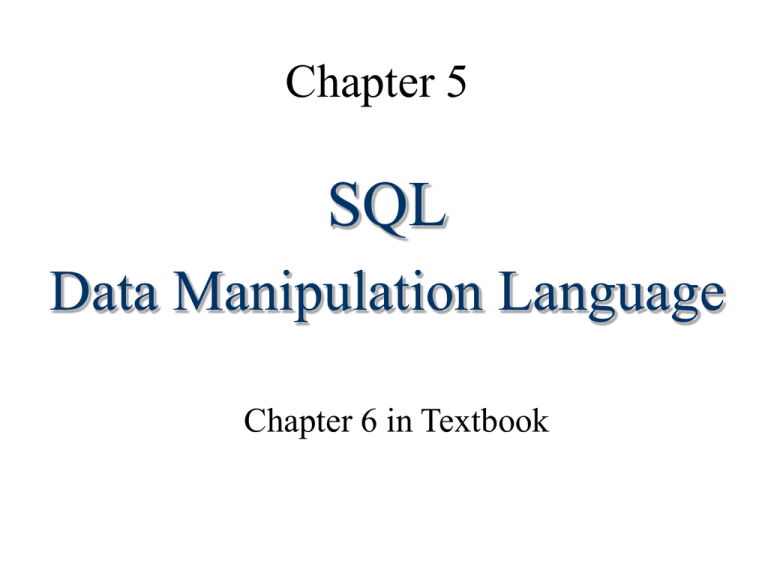
Chapter 5
SQL
Data Manipulation Language
Chapter 6 in Textbook
Database Design
Steps in building a database for an application:
Real-world
domain
SQL (DML)
Conceptual
model
DBMS data
model
Create
Schema
(DDL)
Modify
data (DML)
2
Data Manipulation Language
(DML) Statements
The main SQL data manipulation language statements are:
SELECT
INSERT INTO
UPDATE
DELETE FROM
SQL (DML)
3
Notations
Notations to define SQL statements:
• UPPER-CASE letters represents reserved words.
• Lower-case letters represents user-defined words.
• | indicates a choice among alternatives; (e.g. a | b | c).
• { } indicates a required element.
• [ ] indicates an optional element.
• … indicates optional repetition of an item zero or more times.
• Underlined words represent default values.
SQL (DML)
4
Simple Queries
Syntax
SELECT [DISTINCT|ALL]{*|column|column_expression [AS new_name][,…]}
FROM
table_name [alias] [, … ]
[WHERE condition]
[GROUP BY column_list]
[HAVING condition]
[ORDER BY column_list [ASC|DESC]];
column represents a column name.
column_expression represents an expression on a column.
table_name is the name of an existing database table or view.
FROM specifies the table(s) to be used.
WHERE filters the rows subject to some condition.
GROUP BY forms groups of rows with the same column name.
SELECT specifies which column are to appear in the output.
ORDER BY specifies the order of the output.
Order of the clauses in the SELECT statement can not be changed.
The result of a query is another table.
Asterisk (*) means all columns.
5
Simple Queries
Retrieve all columns & rows
Syntax
SELECT {* | column| column_expression [,…]}
FROM
table_name;
Example: STAFF(sno, fname, lname, position, sex, dob, salary, bno)
Retrieve all staff information.
SELECT
FROM
sno, fname, lname, position, sex, dob, salary, bno
staff;
OR
SELECT
FROM
SQL (DML)
*
staff;
6
Sno
FName
LName position
Sex
DOB
Salary bno
SL21
John
White
Manager
M
1-Oct-45
SG37
Ann
Beech Assistant
F
10-Nov-60 12000 B003
SG14
David
Ford
Supervisor M
24-Mar-58 18000 B003
SA9
Mary
Howe
Assistant
F
19-Feb-70 9000
SG5
Susan
Brand
Manager
F
13-Jun-40 24000 B003
SQL (DML)
30000 B005
B007
7
Simple Queries
Retrieve specific columns & all rows
Example:
STAFF(sno, fname, lname, position, sex, dob, salary, bno)
List salaries of all staff, showing only the staff number, the first and last
name, and salary.
SELECT
FROM
sno, fname, lname, salary
staff;
SQL (DML)
8
Sno
SQL (DML)
FName
LName
Salary
SL21
John
White
30000
SG37
Ann
Beech
12000
SG14
David
Ford
18000
SA9
Mary
Howe
9000
SG5
Susan
Brand
24000
9
Simple Queries
Use of DISTINCT
DISTINCT eliminates duplicated tuples.
Syntax
SELECT [DISTINCT|ALL] {* | column |column_expression [,…]}
FROM
table_name;
Example:
STAFF(sno, fname, lname, position, sex, dob, salary, bno)
List the available positions for staff .
SELECT DISTINCT position
FROM staff;
SQL (DML)
10
position
position
Manager
Manager
Assistant
Assistant
Supervisor
Supervisor
Assistant
Manager
SELECT DISTINCT position
FROM staff;
SELECT position
FROM staff;
SQL (DML)
11
Simple Queries
Calculated fields
The SQL expression in the SELECT list specifies a derived field.
Columns referenced in the arithmetic expression must have a numeric type.
SQL expression can involve + , - , * , / , ( , ).
AS clause is used to name the derived column.
Syntax
SELECT {* | column| column_expression [AS new_name] [,…]}
FROM
table_name;
Example:
STAFF(sno, fname, lname, position, sex, dob, salary, bno)
List the monthly salaries for all staff, showing the staff number, the first and last
names.
SELECT sno, fname, lname, salary/12 AS MonthlySalary
FROM staff;
SQL (DML)
12
Sno
SQL (DML)
FName
LName MonthlySalary
SL21
John
White
2500
SG37
Ann
Beech
1000
SG14
David
Ford
1500
SA9
Mary
Howe
750
SG5
Susan
Brand
2000
13
Simple Queries
Row selection (WHERE clause)
WHERE clause consists of five basic search conditions:
Comparison: Compare the value of one expression to the value of another
expression (= , <, >, <=, >=, <>).
Range: Test whether the value of an expression falls within a specified range of
values (BETWEEN/ NOT BETWEEN).
Set membership: Test whether the value of an expression equals one of a set of
values (IN/ NOT IN).
Pattern match: Test whether a string matches a specified pattern (LIKE/ NOT
LIKE).
NULL: Test whether a column has null value (IS NULL/ IS NOT NULL).
SQL (DML)
14
Simple Queries
Comparison search condition
Comparison operators: = , < , > , <= , >= , <>
Syntax
SELECT [DISTINCT|ALL] {* | column| [column_expression [AS
new_name]] [,…]}
FROM
table_name
[WHERE condition];
Example:
STAFF(sno, fname, lname, position, sex, dob, salary, bno)
List all staff with a salary greater than 10,000. showing number, name and
salary.
SELECT sno, fname, lname, salary
FROM staff
WHERE salary > 10000;
SQL (DML)
15
Sno
SQL (DML)
FName
LName
Salary
SL21
John
White
30000
SG37
Ann
Beech
12000
SG14
David
Ford
18000
SG5
Susan
Brand
24000
16
Simple Queries
Compound comparison search condition
Compound comparison operators: AND , OR , NOT , ( )
Order of evaluation:
• Expression is evaluated left to right
• Between brackets
• NOT
• AND
• OR
Example:
STAFF(sno, fname, lname, position, sex, dob, salary, bno)
List all staff who works as managers or assistants.
SELECT sno, fname, lname, position
FROM staff
WHERE position = ‘Manager’ OR position = ‘Assistant’;
SQL (DML)
17
Sno
SQL (DML)
FName
LName
position
SL21
John
White
Manager
SG37
Ann
Beech
Assistant
SA9
Mary
Howe
Assistant
SG5
Susan
Brand
Manager
18
Simple Queries
BETWEEN/ NOT BETWEEN
BETWEEN checks if a value is within a range.
NOT BETWEEN checks if a value is outside a range.
Example:
STAFF(sno, fname, lname, position, sex, dob, salary, bno)
List all staff with a salary between 20000 and 30000.
SELECT sno, fname, lname, salary
FROM staff
WHERE salary BETWEEN 20000 AND 30000;
This would be expressed as:
SELECT sno, fname, lname, salary
FROM staff
WHERE salary >= 20000 AND salary <= 30000;
SQL (DML)
19
Sno
SQL (DML)
FName
LName
Salary
SL21
John
White
30000
SG5
Susan
Brand
24000
20
Simple Queries
IN/ NOT IN
IN tests whether a data value matches one of a list values.
NOT IN checks for data values that do not lie in a specific list of values.
Example:
STAFF(sno, fname, lname, position, sex, dob, salary, bno)
List all Managers or Assistants.
SELECT sno, fname, lname, position
FROM staff
WHERE
position IN (‘Manager’, ‘Assistant’);
This would be expressed as:
SELECT sno, fname, lname, position
FROM staff
WHERE
position = ‘Manager’ OR position = ’Assistant’;
SQL (DML)
21
Sno
SQL (DML)
FName
LName
position
SL21
John
White
Manager
SG37
Ann
Beech
Assistant
SA9
Mary
Howe
Assistant
SG5
Susan
Brand
Manager
22
Simple Queries
LIKE/ NOT LIKE
SQL has special pattern matching symbol:
% represents any sequence of zero or more character (wildcard)
_ represents any single character
Example:
Address LIKE ‘H%’ means that the first character must be H, but the rest can be
anything.
Address LIKE ‘H_ _ _’ means that there must be exactly four characters in the
string, the first of which must be H.
Address LIKE ‘%e’ means any sequence of characters, of length at least 1, with
the last character an e.
Address LIKE ‘%Glasgow%’ means a sequence of characters of any length
containing Glasgow.
Address NOT LIKE ‘H%’ means the first character can not be H.
23
Simple Queries
LIKE/ NOT LIKE
If the search string can include the pattern-matching character itself, we can
use an escape character to represent the pattern matching character.
‘15%’ is represented by LIKE ‘15#%’ ESCAPE ‘#’
Example:
STAFF(sno, fname, lname, position, sex, dob, salary, address, bno)
List all staff with the string ‘Glasgow’ in their address.
SELECT sno, fname, lname, address
FROM staff
WHERE
address LIKE ‘%Glasgow%’;
SQL (DML)
24
Sno
SQL (DML)
FName
LName
address
SL21
John
White
Achray St,Glasgow G32 9DX
SG37
Ann
Beech
Well St, Glasgow G42
25
Simple Queries
IS NULL/ IS NOT NULL
NULL represents missing or unknown value.
NULL can does not represent a zero or a string of blank spaces.
A NULL value can not be tested with = or<> to another string.
We have to test for NULL explicitly.
Example:
VIEWING (ClientNo, PropertyNo, ViewDate, Comment)
List the details of all viewing on property PG4 where a comment has not been
supplied.
SELECT clientno, ViewDate
FROM viewing
WHERE PropertyNo= ‘PG4’ AND
SQL (DML)
comment IS NULL;
26
Question
Assume the following relational schema:
EMPLOYEE(Fname, Lname, SSN, DOB, Address, Sex, salary, DeptNo)
DEPARTMENT(Dname, DNo )
PROJECT(PName, PNo, PLocation, Dno)
WORKS_ON(SSN, PNo, Hours)
List all employees in department 5 whose salary is between $30,000 & $40,000.
SQL (DML)
27
Simple Queries
ORDER BY clause
Allows the retrieved records to be ordered in ascending (ASC) or descending
order (DESC) on any column or combination of columns.
Syntax
SELECT {* | [column_expression] [,…]}
FROM
table_name
[ORDER BY column_list [ASC|DESC] ]
Single Column ordering
STAFF(sno, fname, lname, position, sex, dob, salary, bno)
Produce a list of salaries for all staff, arranged in descending order of salary.
SELECT sno, fname, lname, salary
FROM staff
ORDER BY salary DESC;
SQL (DML)
28
Simple Queries
ORDER BY clause
Multiple columns ordering
Property (PropertyNo, Street, City, postcode, Type, OwnerNo, Rooms, Rent)
Produce a list of properties arranged in order of property type and within
each property type ordered by rent in descending order.
SELECT propertyNo, type, rooms, rent
FROM property
ORDER BY type, rent DESC;
SQL (DML)
29
PropertNo
SQL (DML)
Type
Rooms
Rent
PG16
Flat
4
450
PL94
Flat
4
400
PG36
Flat
3
370
PG4
House
3
650
PA14
House
6
600
30
Question
Assume the following relational schema:
EMPLOYEE(Fname, Lname, SSN, DOB, Address, Sex, salary, DeptNo)
DEPARTMENT(Dname, DNo )
PROJECT(PName, PNo, PLocation, Dno)
WORKS_ON(SSN, PNo, Hours)
List all employees, ordered by department and, within each department, ordered
alphabetically by last name, first name.
SQL (DML)
31
Simple Queries
Aggregation
Functions that operate on a single column of a table and return a single value.
Five aggregation functions defined in SQL:
COUNT returns the number of rows in a specified column.
SUM
returns the sum of the values in a specified column.
AVG
returns the average of the values in a specified column.
MIN
returns the smallest value in a specified column.
MAX
returns the largest value in a specified column.
Examples:
Property (PropertyNo, Street, City, postcode, Type, OwnerNo, Rooms, Rent)
How many properties cost more than 350 per month to rent?
SELECT COUNT(*) AS count
FROM property
WHERE
rent > 350;
count
2
32
Simple Queries
Aggregation
VIEWING (ClientNo, PropertyNo, ViewDate, Comment)
How many different properties were viewed in May 1998?
SELECT COUNT(DISTINCT PropertyNo) AS count
FROM viewing
WHERE Viewdate
BETWEEN ‘1-May-98’ AND
‘31-May-98’;
count
2
SQL (DML)
33
Simple Queries
Aggregation
STAFF(sno, fname, lname, position, sex, dob, salary, bno)
Find the total number of Managers and the sum of their salaries.
SELECT COUNT(sno) AS count, SUM(salary)
FROM
staff
WHERE
position = ‘Manager’;
SQL (DML)
count
sum
2
54000
AS
sum
34
Simple Queries
Aggregation
STAFF(sno, fname, lname, position, sex, dob, salary, bno)
Find the minimum, maximum, and average staff salary.
SELECT MIN(salary) AS
AVG(salary) AS avg
FROM staff;
SQL (DML)
min,
MAX(salary)
min
max
avg
9000
30000
17000
AS
max,
35
Simple Queries
GROUP BY clause
Groups the data from the SELECT table(s) and produces a single summary
row for each group.
Example:
STAFF(sno, fname, lname, position, sex, dob, salary, bno)
Find the number of staff working in each branch and the sum of their
salaries.
SELECT bno, COUNT(sno) AS count, SUM(salary) AS sum
FROM staff
count
bno
GROUP BY bno;
SQL (DML)
sum
B003
3
54000
B005
2
39000
B007
1
9000
36
Simple Queries
GROUP BY clause
bno
sno
salary
B003
SG37
12000
B003
SG14
18000
B003
SG5
B005
count
sum
24000
3
54000
SL21
30000
2
39000
B005
SL41
9000
1
9000
B007
SA9
9000
SQL (DML)
37
Simple Queries
HAVING clause
Designed for use with the GROUP BY clause to restrict the groups that appear in
the final result table.
WHERE clause filters individual rows going into the final result table.
HAVING clause filters groups going into the final result table.
Example:
STAFF(sno, fname, lname, position, sex, dob, salary, bno)
For each branch office with more than one member of staff, find the number of
staff working in each branch and the sum of their salaries.
SELECT bno, COUNT(sno) AS count, SUM(salary) AS sum
FROM staff
count
bno
GROUP BY bno
HAVING COUNT(sno) > 1;
B003
3
B005
SQL (DML)
2
sum
54000
39000
38
Question
Assume the following relational schema:
EMPLOYEE(Fname, Lname, SSN, DOB, Address, Sex, salary, DeptNo)
DEPARTMENT(Dname, DNo )
PROJECT(PName, PNo, PLocation, Dno)
WORKS_ON(SSN, PNo, Hours)
For each project on which more than two employees work, retrieve the project
number and the number of employees who work on the project.
SQL (DML)
39
Subqueries
A complete SELECT statement can be embedded (subselect) within another
SELECT statement.
A subselect can be used in the WHERE and HAVING clauses of the outer
SELECT statement (nested query).
A subquery can be used immediately following a relational operator.
Subquery always enclosed in parentheses.
Type of subquery:
A scalar subquery returns a single column and a single row (singlevalue).
A row subquery returns multiple columns, but a single row.
A table subquery returns one or more columns and multiple rows.
SQL (DML)
40
Subqueries
STAFF (sno, fname, lname, position, sex, DOB, salary, bno)
BRANCH (bno, street, city, postcode)
Example:
List the staff who work in the branch at ‘163 Main St’.
SELECT sno, fname, lname, position
FROM staff
WHERE bno = (SELECT bno
FROM branch
WHERE street = ‘163 Main St’);
SQL (DML)
41
Subqueries
STAFF (sno, fname, lname, position, sex, DOB, salary, bno)
Example:
List the staff whose salary is greater than the average salary, and list by how
much their salary is greater than the average.
SELECT sno, fname, lname, position, salary – (SELECT
avg(salary) FROM staff ) AS sal_diff
FROM staff
WHERE salary > ( SELECT avg(salary)
FROM staff );
SQL (DML)
42
Subqueries
The following rules apply to subqueries:
The ORDER BY clause may not be used in a subquery .
The subquery SELECT list must consist of a single column name or
expression, except for subqueries that use the keyword EXISTS.
By default, column names in a subquery refer to the table name in the
FROM clause of the subquery. It is possible to refer to a table in a FROM
clause in an outer query by qualifying the column name; in this case the
subquery is called a correlated subquery.
When a subquery is one of the two operands involved in a comparison, the
subquery must appear on the right-hand side of the comparison.
SQL (DML)
43
Subqueries
IN
PROPERTYFORRENT (pno, street, area, city, pcode, type, rooms, rent, sno)
STAFF (sno, fname, lname, position, sex, DOB, salary, bno)
BRANCH (bno, street, city, postcode)
Example:
List the properties that are handled by staff who work in the branch at ‘163 Main
St’.
SELECT pno, street, area, city, pcode, type, rooms, rent
FROM property_for_rent
WHERE sno IN
(SELECT sno
FROM staff
WHERE bno =
(SELECT bno
FROM branch
WHERE street = ‘163 MainSt’));
SQL (DML)
44
Question
Assume the following relational schema:
EMPLOYEE(Fname, Lname, SSN, DOB, Address, Sex, salary, DeptNo)
DEPARTMENT(Dname, DNo )
PROJECT(PName, PNo, PLocation, Dno)
WORKS_ON(SSN, PNo, Hours)
Show the resulting salaries if every employee working on ‘X’ project is given all %10
raise.
SQL (DML)
45
Subqueries
ANY/ ALL
Used with subqueries that produce a single column of numbers.
If the subquery is preceded by the keyword ALL, the condition will only be
true if it is satisfied by all values produced by the subquery.
If the subquery is preceded by the keyword ANY or SOME, the condition
will be true if it is satisfied by any (one or more) values produced by the
subquery.
SQL (DML)
46
Subqueries
ANY/ ALL
STAFF (sno, fname, lname, position, sex, DOB, salary, bno)
Example:
Find staff whose salary is larger than the salary of at least one member of
staff at branch B3.
SELECT sno, fname, lname, position, salary
FROM staff
WHERE salary > SOME
(SELECT salary
FROM staff
WHERE bno = ‘B3’);
SQL (DML)
47
sno
SQL (DML)
FName
LName
position
salary
SL21
John
White
Manager
30000
SG14
David
Ford
Supervisor
18000
SG5
Susan
Brand
Manager
24000
48
Subqueries
ANY/ ALL
STAFF (sno, fname, lname, position, sex, DOB, salary, bno)
Example:
Find staff whose salary is larger than the salary of every member of staff at
branch B3.
SELECT sno, fname, lname, position, salary
FROM staff
WHERE salary > ALL
(SELECT salary
FROM staff
WHERE bno = ‘B3’);
SQL (DML)
49
Sno
SL21
SQL (DML)
FName
John
LName
position
salary
White
Manager
30000
50
Homework Question
Assume the following relational schema:
EMPLOYEE (Fname, Lname, SSN, DOB, Address, Sex, salary, DeptNo)
DEPARTMENT (Dname, DNo )
PROJECT (PName, PNo, PLocation, Dno)
WORKS_ON(SSN, PNo, Hours)
For each department that has more than 5 employees, retrieve the department
number and the number of its employees who are making more than $40,000.
SQL (DML)
51
Multi-Table Queries
So far, the columns that are to appear in the result table must all come from
a single table.
To combine columns from several tables into a result table, we need to use a
join operation.
To perform a join, we include more than one table name in the FROM
clause. WHERE clause to specify the join columns.
SELECT [DISTINCT|ALL] {* |column |[column_expression
[AS new_name]] [,…]}
FROM
table_name [alias] [, … ]
[WHERE condition];
SQL (DML)
52
Simple Join
CLIENT (ClientNo, Fname, Lname, telNo, Type, Rent)
VIEWING (ClientNo, PropertyNo, Date, Comment)
Example:
List the names of all clients who have viewed a property along with any
comment supplied.
SELECT c.clientNo, fname, lname, propertyNo,
FROM client c, viewing v
WHERE c.clientNo = v.clientNo;
comment
Alternatives:
FROM
client c
JOIN
viewing
v
ON
FROM
client
JOIN
viewing
USING
FROM
client NATURAL JOIN
c.clientNo = v.clientNo;
clientNo;
viewing;
53
Sorting a Join
PROPERTYFORRENT (pno, street, area, city, pcode, type, rooms, rent, sno)
STAFF (sno, fname, lname, position, sex, DOB, salary, bno)
BRANCH (bno, street, city, postcode)
Example:
For each branch office, list the names of staff who manage properties, and
the properties they manage, ordered by branch number, staff number and
property number.
SELECT s.bno, s.sno, fname, lname,
FROM staff s, propertyforrent p
WHERE s.sno = p.sno
ORDER BY s.bno, s.sno, p.pno;
SQL (DML)
pno
54
bno
SQL (DML)
Sno
FName
LName
pno
B003
SG14
David
Ford
PG16
B003
SG37
Ann
Beech
PG21
B003
SG37
Ann
Beech
PG36
B005
SL41
Julie
Lee
PL94
B007
SA9
Mary
Howe
PA14
55
Question
Assume the following relational schema:
EMPLOYEE (Fname, Lname, SSN, DOB, Address, Sex, salary, DeptNo)
DEPARTMENT (Dname, DNo )
PROJECT (PName, PNo, PLocation, Dno)
WORKS_ON(SSN, PNo, Hours)
List all employees and identify the projects they are working on, ordered by
department and, within each department, ordered alphabetically by last name, first
name.
SQL (DML)
56
Three-Table Join
PROPERTYFORRENT (pno, street, area, city, pcode, type, rooms, rent, sno)
STAFF (sno, fname, lname, position, sex, DOB, salary, bno)
BRANCH (bno, street, city, postcode)
Example:
For each branch, list the staff who manage properties, including the city in which
the branch is located and the properties they manage.
SELECT b.bno, b.city, s.sno, fname, lname, pno
FROM branch b, staff s, propertyForRent p
WHERE b.bno = s.bno AND s.sno = p.sno;
Alternatives:
FROM
(Branch b
SQL (DML)
JOIN
JOIN
staff s USING bno) As bs
PropertyForRent p USING sno;
57
Multiple grouping columns
PROPERTYFORRENT (pno, street, area, city, pcode, type, rooms, rent, sno)
STAFF (sno, fname, lname, position, sex, DOB, salary, bno)
BRANCH (bno, street, city, postcode)
Exmaple:
Find the number of properties handled by each staff member and branch.
SELECT s.bno, s.sno, COUNT(*) AS count
FROM staff s, propertyForRent p
WHERE s.sno = p.sno
GROUP BY s.bno, s.sno;
SQL (DML)
58
SQL (DML)
bno
Sno
count
B003
SG14
1
B003
B005
SG37
SL41
2
B007
SA9
1
1
59
Computing a Join
A join is a subset of the Cartesian product.
The Cartesian product of two tables is another table consisting of all possible pairs of
rows from the two table.
The columns of the product table are all the columns of the first table followed by all
the columns of the second table.
Format of SELECT statement for the Cartesian product:
SELECT [DISTICNT | ALL] {* | column_list }
FROM table_name1 CROSS JOIN table_name2;
SQL (DML)
60
Computing a Join
The procedure for generating the results of a SELECT with a join are as
follows:
• Form the Cartesian product of the tables named in the FROM clause.
• If there is a WHERE clause, apply the search condition to each row of the
product table, retaining those rows that satisfy the condition. In terms of the
relational algebra, this operation yields a restriction of the Cartesian product.
• For each remaining row, determine the value of each item in the SELECT list to
produce a single row in the result table.
• If SELECT DISTINCT has been specified, eliminate any duplicate rows from the
result table.
• If there is an ORDER BY clause, sort the result table as required.
SQL (DML)
61
Outer Join
The join operation combines data from two tables by forming pairs of related
rows where the matching columns in each table have the same value. If one
row of a table is unmatched, the row is omitted from the result table.
Outer join include the unmatched rows in the result table.
Three types of outer join:
- Left
- Right
- Full
SQL (DML)
62
Join Example
PROPERTY
BRANCH
BranchNo
PropertyNo
bCity
pCity
B003
Glasgow
PA14
Aberdeen
B004
Bristol
PL94
London
B002
London
PG4
Glasgow
BranchNo
bCity
PropertyNo pCity
B003
Glasgow
PG4
Glasgow
B002
London
PL94
London
SELECT
b.*, p.*
FROM branch b, property p
WHERE b.bcity = p.pcity;
SQL (DML)
63
Left Outer Join
Example:
List the branch offices and properties that are in the same city along with any
unmatched branches.
SELECT b.*, p.*
FROM branch b
LEFT JOIN property p ON
b.bcity = p.pcity;
SQL (DML)
64
PROPERTY
BRANCH
BranchNo
PropertyNo
bCity
B003
Glasgow
PA14
Aberdeen
B004
Bristol
PL94
London
B002
London
PG4
Glasgow
BranchNo
bCity
PropertyNo pCity
B003
Glasgow
PG4
Glasgow
B004
Bristol
NULL
NULL
B002
London
PL94
London
SELECT b.*, p.*
FROM branch b
LEFT JOIN property
b.bcity =
SQL (DML)
pCity
p ON
p.pcity;
65
Right Outer Join
Example:
List the branch offices and properties in the same city and any unmatched
property.
SELECT b.*, p.*
FROM branch b
RIGHT JOIN property p ON
b.bcity = p.pcity;
SQL (DML)
66
PROPERTY
BRANCH
BranchNo
PropertyNo
bCity
pCity
B003
Glasgow
PA14
Aberdeen
B004
Bristol
PL94
London
B002
London
PG4
Glasgow
BranchNo
bCity
PropertyNo pCity
NULL
NULL
PA14
Aberdeen
B003
Glasgow
PL94
London
B002
London
PG4
Glasgow
SELECT b.*, p.*
FROM branch b
RIGHT JOIN property p ON
b.bcity = p.pcity;
SQL (DML)
67
Full Outer Join
Example:
List the branch offices and properties that are in the same city and any
unmatched branches or properties.
SELECT b.*, p.*
FROM branch b
FULL JOIN property p ON
b.bcity = p.pcity;
SQL (DML)
68
PROPERTY
BRANCH
BranchNo
PropertyNo
bCity
pCity
B003
Glasgow
PA14
Aberdeen
B004
Bristol
PL94
London
B002
London
PG4
Glasgow
BranchNo
bCity
PropertyNo pCity
NULL
NULL
PA14
Aberdeen
B003
Glasgow
PG4
Glasgow
B004
Bristol
NULL
NULL
B002
London
PL94
London
SELECT b.*, p.*
FROM branch b
FULL JOIN property p ON
b.bcity = p.pcity;
SQL (DML)
69
EXIST/ NOT EXIST
Used only with correlated subqueries.
EXISTS is true if and only if there exists at least one row in the result table
returned by the subquery. It is false if the subquery returns an empty result
table.
Example:
STAFF (sno, fname, lname, position, sex, DOB, salary, bno)
BRANCH (bno, street, city, postcode)
Find all staff who work in a London branch.
SELECT sno, fname, lname, position
FROM staff s
WHERE EXISTS
(SELECT *
FROM branch b
WHERE s.bno = b.bno AND city
SQL (DML)
= ‘London’);
70
Question
Assume the following relational schema:
EMPLOYEE (Fname, Lname, SSN, DOB, Address, Sex, salary, DeptNo)
DEPARTMENT (Dname, DNo )
PROJECT (PName, PNo, PLocation, Dno)
WORKS_ON(SSN, PNo, Hours)
Retrieve the names of employees who works on no project.
SQL (DML)
71
UNION
PROPERTYFORRENT (pno, street, area, city, pcode, type, rooms, rent, sno)
STAFF (sno, fname, lname, position, sex, DOB, salary, bno)
BRANCH (bno, street, city, postcode)
Example:
Construct a list of all cities where there is either a branch office or a rental
property.
(SELECT
UNION
(SELECT
SQL (DML)
city
FROM
branch)
city
FROM
propertyforrent);
72
INTERSECT
Example:
Construct a list of all cities where there is both a branch office and a rental
property.
(SELECT city
INTERSECT
(SELECT city
FROM
branch)
FROM propertyforrent);
SELECT DISTINCT b.city
FROM branch b, propertyforrent
WHERE b.city=p.city;
p
SELECT DISTINCT city
FROM
branch b
WHERE EXISTS
(SELECT *
FROM propertyforrent p
WHERE p.city = b.city);
73
EXCEPT
Example:
Construct a list of all cities where there is a branch office but no rental
property.
(SELECT
EXCEPT
(SELECT
city
FROM
branch)
city
FROM propertyforrent);
SELECT DISTINCT city
FROM branch
WHERE city NOT IN
(SELECT
city
FROM propertyforrent);
SELECT DISTINCT city
FROM
branch b
WHERE NOT EXISTS
(SELECT * FROM propertyforrent p
WHERE p.city = b.city);
74
Adding Data to DB (INSERT)
Syntax
INSERT INTO table_name [(column (,…))]
{ VALUES (date_value (,…)) | subquery };
table_name may be either a base table or an updatable view.
column_list represents a list of one or more column names separated by commas.
If omitted, SQL assumes a list of all columns in their original CREATE TABLE order.
If specified, then any columns that are omitted from the list must have been
declared as NULL column.
data_value must match the column_list as follows:
The number of items in each list must be same.
There must be a direct correspondence in the position of items in the two lists,
so that the first item in the data_value_list applies to the first item in the
column_list, and so on.
The data type of each item in the data_value_list must be compatible with the
data type of the corresponding column.
75
Simple INSERT
STAFF(sno, fname, lname, position, sex, DOB, salary, bno)
Example:
Insert a new row into the staff table supplying data for all columns.
INSERT INTO staff
VALUES (‘SG16’, ‘Alan’, ‘Brown’, ‘Assistant’, ‘M’,
DATE ‘1957-05-25’, 8300, ‘B003’);
SQL (DML)
76
Simple INSERT
STAFF(sno, fname, lname, position, sex, DOB, salary, bno)
Example:
Insert a new row into the staff table supplying data for all mandatory columns, knowing
that the sex and birth date are optional fields.
INSERT INTO staff (Sno, fname, lname, position, salary, bno)
VALUES (‘SG16’, ‘Alan’, ‘Brown’, ‘Assistant’, 8300, ‘B003’);
Alternative:
INSERT INTO staff
VALUES (‘SG16’, ‘Alan’, ‘Brown’, ‘Assistant’, NULL, NULL, 8300,
‘B003’);
SQL (DML)
77
INSERT with subqueries
STAFF(sno, fname, lname, position, sex, DOB, salary, bno)
PROPERTYFORRENT(Pno, street, city, postcode, type, rooms, rent, ono, sno, bno)
StaffPropCount(sno, fname, lname, propcount)
Example:
Insert rows into the StaffPropCount table using the staff and property_for_rent
tables.
INSERT INTO staffPropCount
(SELECT s.sno, fname, lname, COUNT(*)
FROM staff s, PropertyForRent p
WHERE s.sno = p.sno
GROUP BY s.sno, fname, lname)
UNION
(SELECT sno, fname, lname, 0
FROM Staff
WHERE sno NOT IN (SELECT DISTINCT sno
FROM PropertyForRent));
78
Sno
SQL (DML)
FName
LName
propCount
SG14
David
Ford
1
SL21
John
White
0
SG37
Ann
Beech
2
SA9
Mary
Howe
1
SG5
Susan
Brand
0
SL41
Julie
Lee
1
79
Modifying Data in the DB
(UPDATE)
Syntax
UPDATE table_name
SET column_name1 = data_value1 [, column_namei =
data_valuei ...]
[WHERE search_condition]
table_name may be either a base table or an updatable view.
The SET clause specifies the names of one or more columns
that are updated for all rows in the table.
Only rows that satisfy the search_condition are updated.
data_values must be compatible with the data types for the
corresponding columns.
SQL (DML)
80
Simple UPDATE
STAFF(sno, fname, lname, position, sex, DOB, salary, bno)
Example:
Give all staff a 3% pay increase.
UPDATE staff
SET salary = salary * 1.03;
Example:
Give all managers a 3% pay increase.
UPDATE staff
SET salary = salary * 1.03
WHERE position = ‘Manager’;
SQL (DML)
81
Simple UPDATE
STAFF(sno, fname, lname, position, sex, DOB, salary, bno)
Example:
Promote David Ford (sno = ‘SG14’) to Manager and change his salary to
$18,000.
UPDATE staff
SET position=‘Manager’, salary = 18000
WHERE sno=‘SG14’;
SQL (DML)
82
Deleting Data from the DB
(DELETE)
Syntax
DELETE
FROM table_name
[WHERE search_condition];
table_name may be either a base table or an updatable view.
Only rows that satisfy the search_condition are deleted.
If no search_condition is omitted, all rows are deleted
from the table.
DELETE does not delete the table itself, only rows in the
table.
SQL (DML)
83
Simple DELETE
STAFF(sno, fname, lname, position, sex, DOB, salary, bno)
Example:
Delete all staff in branch B003.
DELETE FROM staff
WHERE bno = ‘B003’;
Example:
Delete all staff.
DELETE FROM staff;
SQL (DML)
84







